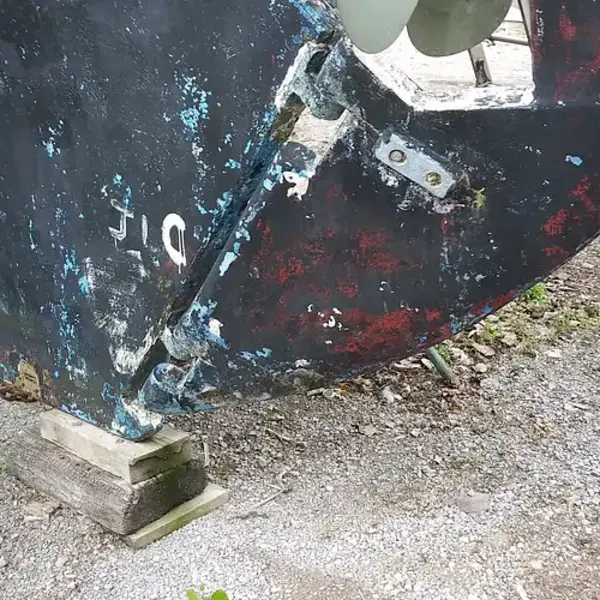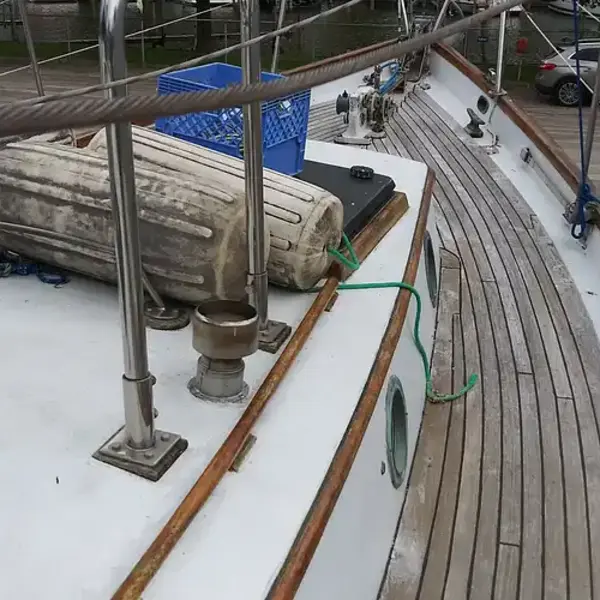Seller's Description
This 1977 Rafiki 37 designed by Stan Huntingford is a solidly built bluewater boat that is currently in inside storage in Bay City Michigan and has been in freshwater the last 25 years.
The sellers have owned the boat since 1999 and have used it only on the great lakes since then. The boat has been on the hard for 5 years and if the seller was not 77 years old, he says they’d be launching the boat this spring and going sailing!!
There are a few condition issues, but the sellers have had only a couple minor nuisance leaks. The starboard engine support is moist, though no issues were ever observed when operating the engine.
The teak deck on the bow has been rebunged (275 screws), the starboard side deck has been done and the port side needs to be done. The sellers have never felt any sponginess or flexing over their 24 years of ownership.
Engine was last run in 2020, the fuel in the tank should be replaced (45gallons). Aside from the items above the sellers have made some terrific upgrades in the last 8 years.
A New Harken roller furler was installed in ~2017, with a new headstay and genoa. The main is in good shape. A new dodger and bimini were installed in 2018.
The headstay was replaced with the new furler was installed, All other standing rigging is original. . Running rigging is in good shape.
The seller will consider all reasonable offers, so don’t be shy!
Specs
- Designer
- Stan Huntingford
- Builder
- Lien Hwa Industrial Corp.
- Associations
- ?
- # Built
- 55
- Hull
- Monohull
- Keel
- Long
- Rudder
- Transom hung
- Construction
- FG w/balsa core
Dimensions
- Length Overall
- 36′ 8″ / 11.2 m
- Waterline Length
- 31′ 11″ / 9.8 m
- Beam
- 11′ 11″ / 3.7 m
- Draft
- 6′ 0″ / 1.8 m
- Displacement
- 26,500 lb / 12,020 kg
- Ballast
- 11,500 lb / 5,216 kg
Rig and Sails
- Type
- Cutter
- Reported Sail Area
- 729′² / 67.7 m²
- Total Sail Area
- 729′² / 67.7 m²
Mainsail
- Sail Area
- 353′² / 32.8 m²
- P
- 41′ 6″ / 12.7 m
- E
- 16′ 11″ / 5.2 m
- Air Draft
- ?
Foresail
- Sail Area
- 376′² / 34.9 m²
- I
- 47′ 0″ / 14.3 m
- J
- 16′ 0″ / 4.9 m
- Forestay Length
- 49′ 7″ / 15.1 m
Auxilary Power
- Make
- Volvo
- Model
- ?
- HP
- ?
- Fuel Type
- Diesel
- Fuel Capacity
- 125 gal / 473 l
- Engine Hours
- ?
Accomodations
- Water Capacity
- 195 gal / 738 l
- Holding Tank Capacity
- ?
- Headroom
- ?
- Cabins
- ?
Calculations
- Hull Speed
-
7.5 kn
Classic: 7.58 kn
Hull Speed
The theoretical maximum speed that a displacement hull can move efficiently through the water is determined by it's waterline length and displacement. It may be unable to reach this speed if the boat is underpowered or heavily loaded, though it may exceed this speed given enough power. Read more.
Formula
Classic hull speed formula:
Hull Speed = 1.34 x √LWL
A more accurate formula devised by Dave Gerr in The Propeller Handbook replaces the Speed/Length ratio constant of 1.34 with a calculation based on the Displacement/Length ratio.
Max Speed/Length ratio = 8.26 ÷ Displacement/Length ratio.311
Hull Speed = Max Speed/Length ratio x √LWL
- Sail Area/Displacement
-
13.1
<16: under powered
Sail Area / Displacement Ratio
A measure of the power of the sails relative to the weight of the boat. The higher the number, the higher the performance, but the harder the boat will be to handle. This ratio is a "non-dimensional" value that facilitates comparisons between boats of different types and sizes. Read more.
Formula
SA/D = SA ÷ (D ÷ 64)2/3
- SA: Sail area in square feet, derived by adding the mainsail area to 100% of the foretriangle area (the lateral area above the deck between the mast and the forestay).
- D: Displacement in pounds.
- Ballast/Displacement
-
43.4
>40: stiffer, more powerful
Ballast / Displacement Ratio
A measure of the stability of a boat's hull that suggests how well a monohull will stand up to its sails. The ballast displacement ratio indicates how much of the weight of a boat is placed for maximum stability against capsizing and is an indicator of stiffness and resistance to capsize.
Formula
Ballast / Displacement * 100
- Displacement/Length
-
361.4
300-400: heavy
Displacement / Length Ratio
A measure of the weight of the boat relative to it's length at the waterline. The higher a boat’s D/L ratio, the more easily it will carry a load and the more comfortable its motion will be. The lower a boat's ratio is, the less power it takes to drive the boat to its nominal hull speed or beyond. Read more.
Formula
D/L = (D ÷ 2240) ÷ (0.01 x LWL)³
- D: Displacement of the boat in pounds.
- LWL: Waterline length in feet
- Comfort Ratio
-
44.6
40-50: heavy bluewater boat
Comfort Ratio
This ratio assess how quickly and abruptly a boat’s hull reacts to waves in a significant seaway, these being the elements of a boat’s motion most likely to cause seasickness. Read more.
Formula
Comfort ratio = D ÷ (.65 x (.7 LWL + .3 LOA) x Beam1.33)
- D: Displacement of the boat in pounds
- LWL: Waterline length in feet
- LOA: Length overall in feet
- Beam: Width of boat at the widest point in feet
- Capsize Screening
-
1.6
<2.0: better suited for ocean passages
Capsize Screening Formula
This formula attempts to indicate whether a given boat might be too wide and light to readily right itself after being overturned in extreme conditions. Read more.
Formula
CSV = Beam ÷ ³√(D / 64)
- Beam: Width of boat at the widest point in feet
- D: Displacement of the boat in pounds
This listing is presented by PopYachts.com. Visit their website for more information or to contact the seller.





































































































